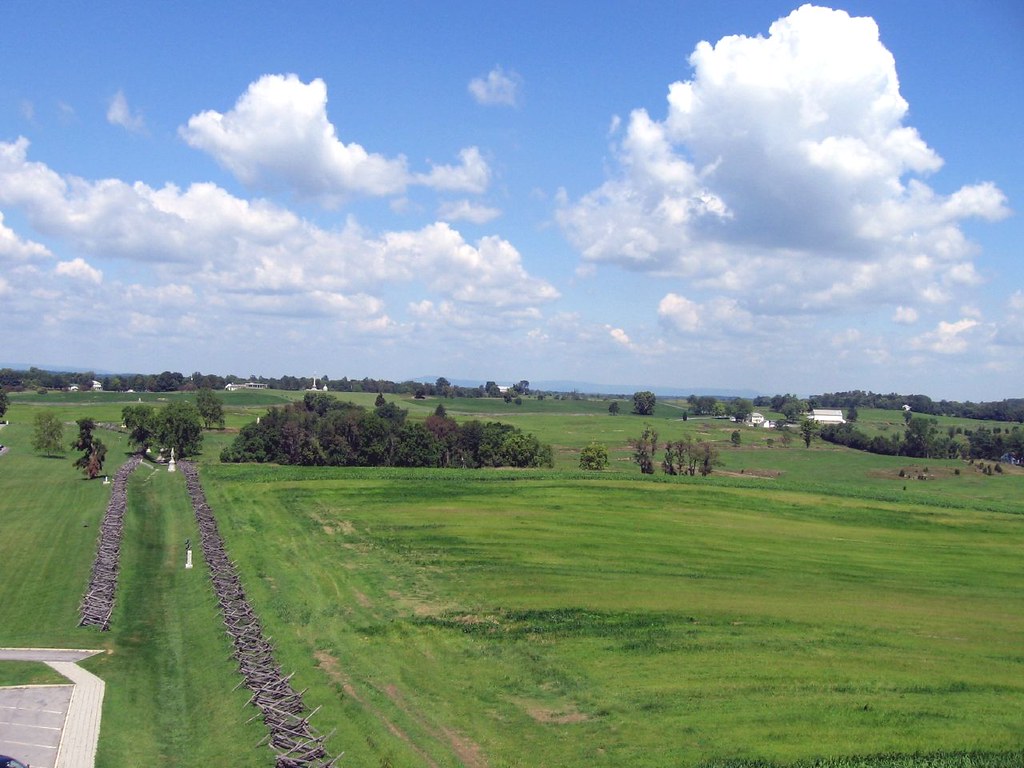I crossed the Potomac River on my way back from Shepherdstown, West Virginia, and drove into Sharpsburg, Maryland a few miles later, the site of the Battle of Antietam. I didn’t have a great deal of time for my visit but I was still able to stop at a few favorite spots within this well-known Civil War battlefield where Maj. Gen. George B. McClellan, commanding the Union army, squared off against Gen. Robert E. Lee and the Confederates (map).
On a single day, September 17, 1862, about 23,000 American soldiers were killed, wounded or went missing, and the Confederate’s first invasion of the north failed. It was the single bloodiest day in the history of the United States, with more casualties than even D-Day in the Second World War.
There are multiple sources describing the battle including the National Park Service’s Antietam National Battlefield page and the inevitable Wikipedia summary, so I won’t go into the details. In fact I can barely scratch the surface in this greatly simplified narrative by focusing on a couple of my favorite examples of geography and topography playing critical roles in a pivotal battle.
Consider the terrain. Start by watching the short video and notice that much of the battlefield hugs gently rolling fields bracketed by woods. It offered long open areas punctuated by hollows, swales and bluffs that troops could drop into or jump out of at key moments.
Sunken Road

The fighting at the Sunken Road provided a prime example. Combat raged through the West Woods and the Cornfield towards the northwest during the morning hours. Fighting then shifted towards the center of the Confederate line at midday. Here, Confederate troops entrenched themselves defensively in the depression of an old wagon road. Union forces surged across a slightly inclined pasture uphill towards the sunken road.
The topography practically guaranteed an intense, violent, brutish face-to-face conflict. Confederated forces rebuffed several Union waves before finally abandoning their position. In a little more than three hours, two opposing armies absorbed 5,600 casualties along a line only 800 yards long. Conservative Union leadership failed to exploit its advantage after taking the sunken road. The Union lost an opportunity to cleave the Confederate line in half and possibly defeat their enemy.
The Sunken Road sits in a depression between the two parallel rows of wooden split-rail fences on the left side of the photograph. The upward sloping pasture extends beyond the right side of the fencing. The lane itself stretches between the observation tower built after the war (where I took this photograph) to the short line of trees. This is an incredibly confined space. Now imagine the carnage that must have occurred along that short line to result in several thousand casualties. It’s easy to see how it came to be known as Bloody Lane.
Burnside Bridge

Meanwhile another assault focused on the Confederate’s right flank further south. Maj. Gen. Ambrose Burnside received orders to capture and cross Rohrbach’s Bridge, the southernmost of three bridges crossing Antietam Creek near the battlefield. It would gain a level of infamy sufficient to be renamed Burnside Bride. The creek might have been forded safely in other locations nearby but those were not used. Burnside focused on the bridge.
Topography played a critical role here, too. Antietam Creek ran between two bluffs. The road leading towards the bridge ran adjacent to the creek. Geographic contours forced the bulk of Union troops down a narrow slot heading towards the foot of the bridge.
The steeper, higher, rockier bluff rose above the opposing bank of the creek. Confederate forces from Georgia took defensive positions high atop this bluff and dug-in to defend the crossing. Several Union waves assaulted the bridge, absorbing relentless fire from above. A small entrenched Confederate force halted the Union advance for three hours single-handedly before retreating. After taking the bridge, Burnside consumed another two hours reorganizing his forces. By that time Confederate reinforcements arrived from Harpers Ferry and the Union lost another opportunity to overrun their foe.
The Union’s cautious approach combined with Confederate leverage of battlefield topography allowed a numerically smaller force to battle an army nearly twice its size to a bloody standstill. Had the Union army exploited either opportunity it could have split Lee’s army or blocked its only escape route back across the Potomac River. Instead, the war raged for another three years.

Leave a Reply